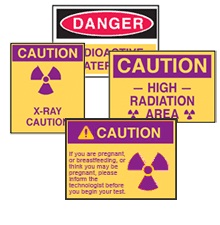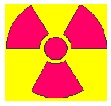

| Contents | Previous | Next |
Radiation exists everywhere in the environment, in rocks, soil, water, and plants. The mining and processing of naturally occurring radioactive materials for use in medicine, power generation, and industry generate emissions and waste. Radiation accidents occur very infrequently, but the dangers are real, and radiation emergencies need to be understood and prepared for. The serious effects (10-30 years after radiation) may cause late injuries, most of all radiation induced cancer occur.
Radiation is the transmission of energy in form of waves or particles (trying to become stable). Ionizing radiation, that is capable of disrupting the atoms in the body into their components charged particles, creates havoc in the molecular building blocks of various body tissues and may lead to early death or to late complications (cancer, leukemia) depending on the extent of exposure. Ionizing radiation is of different types with the following characteristics:
The distribution of the ionization depends on the kind of radiation, its penetrating power, the location of the source, and the nature of the irradiated material. High-energy X-rays penetrate deeply, most beta particles penetrate only a few millimeters, and alfa-particles penetrate only a fraction of a millimeter, but all produce intense ionization along their tracks. Ionizing radiation directly affects living organisms by killing cells or making them malfunction; its indirect effects include the production of gene mutations and chromosome breaks.
People are exposed to background radiation that occurs naturally from the sun, outer space and radioactive materials in the soil. From cosmic radiation (from the sun) we receive a radiation dose of about 0.3 mSv/year, from the bed-rock approximately 0.5 mSv/year, and from radiation sources within the body, approximately 0.2 mSv/year, which gives a background radiation dose of about 1 mSv (millisivert) or 100 millirems. Other sources of radioactive materials include industrial measurement devices, radio therapeutics used for medical diagnoses and treatment, university research centers, radon in our houses or flats, nuclear power plants, and nuclear waste processes.
The gray (Gy), 1 Gy=100 rads, is a unit of measure for absorbed dose and reflects the amount of energy deposited into a mass of tissue. In connection with radiotherapy, treatment of cancer tumors, gives locally very high doses, often 50-60 Gy, in organ dose, to kill malignant cells (Lennquist, 2002). For comparison, one chest X-ray is about 0.02 mSv, and an abdominal scan approximately less than 10 mSv.
Industrial accidents involving nuclear plants have been rare, but when they do occur, they tend to elicit panic reactions. The accident at Harrisburg, Three Miles Island in 1979, and the Chernobyl disaster 1986 in the Ukraine (then part of the Soviet Union) brought sharply the potential dangers of a radiation (nuclear) accident into public consciousness; the Chernobyl accident also sent a radioactive cloud across Europe. The number of victims after that the Chernobyl reactor 4 exploded is disputed. Within 3 months, 28 persons died of radiation- and burn injuries; and several extra cases of cancer are expected within a 50-year-period.
Japan is now facing a nuclear crisis after a 9.0-magnitude earthquake and tsunami hit the country on March 11, 2011. The Fukushima Daiichi nuclear disaster, a nuclear power plant 140 miles north of Tokyo, damaged by a series of fires, equipment failures and releases of radioactive materials, are more complex as multiple reactors are involved, and the Japanese authorities have been struggling to prevent a radiation disaster. People had to evacuate and food grown in the area was banned from sale. Approximately 23,000 people have died or are missing, and 90,000 people live in makeshift apartments three months after the earthquake, tsunami, and emission from nuclear power plants in Fukushima Daiichi in Japan.
Radiation could also be used as a weapon for mass destruction, such as nuclear bombs or improvised devices; terrorists might attack a nuclear power plant, a source placed on mass transportation or in a movie theater, or dirty bombs. If radioactive sources that are lost, abandoned or intentionally placed in areas to expose people, a large number of casualties could occur.
Radiation exposure occurs when all or part of the body is exposed to penetrating radiation, for example X-ray or a CT scan. A substance that emits ionizing radiation is called radioactive, and special instruments, such as a Geiger counter, detect its emissions. Exposure to gamma radiation or X-ray radiation does not make a person radioactive. A person does not give off radiation, unless he or she has been contaminated by dust containing alpha or beta particles.
In a clean radiation accident, most likely to occur at an industrial facility where a radioactive substance become unshielded, and people in the vicinity are exposed to the radiation (there has been no contamination). The victims have been irradiated but are not radioactive.
A dirty radiation accident, typically a transportation accident, in which vehicles carrying materials is involved in a violent collision, resulting in spillage or release into the air of radioactive substances or are otherwise contaminating the accident scene. It is when responding to this kind of dirty radiation accident that special precautions are required. Victims in the immediate vicinity of a dirty bang will present with symptoms of blast or burn injury in addition to radiation exposure.
Contamination refers to radioactive material that is deposited anywhere that they are not supposed to be. They can be a solid, liquid, gas or dust particles. External contamination, on the outside of the body can be removed by taking off clothing and washing the skin with soap and water. Internal contamination, inside the body occurs through inhalation, ingestion or penetrating wounds. Incorporation is the uptake of radioactive materials by body cells, tissues and organs, which take place when contamination occurs.
The effects of radiation depend on the amount of radiation (the dose), the type of radiation, the route of exposures, the length of time of exposure, and the area of the body affected. Pregnant women, the stage of human embryo and fetus, age and pre-existing conditions also affect the radiation sensitivity. Radiation exposure effects can be mild (reddening of the skin) or serious (cancer and deaths). Acute radiation exposure is an exposure of short duration and intense radiation, usually occurring as the result of an accidental spill of radioactive material. Death may occur weeks after exposure to a dose of 2 to 5 gray because of the destructive effects on blood-forming organs, but 6 gray is generally considered the fatal dose (Anderson, Anderson, & Glanze, 1998). Many survivors of the Hiroshima and Nagasaki atomic bomb in the 1940s and many of the firefighters who first responded after the Chernobyl disaster in 1986 become ill with ARS.
Acute Radiation Syndrome (ARS), radiation toxicity or radiation sickness is an acute illness caused by irradiation of the entire body, or most of the body, by a large dose (greater than 0.7 Gy or 70 rads) of penetrating radiation received in a very short time, usually within minutes (CDC - Radiation emergencies, 2005). Radiation sickness, moderate exposure may cause headache, nausea, vomiting, anorexia, and diarrhea; long-term exposure may result in sterility, damage to the fetus in pregnant women, leukemia or other forms of cancer, alopecia, and cataracts (Anderson, Anderson, Glanze, 1998).
The three classic ARS syndromes are:
The four stages of ARS are:
Victims with ARS usually also have some skin damage, Cutaneous Radiation Syndrome (CRS). This damage can start within a few hours after exposure and can include swelling, itching, and erythema, and there can be hair loss. In most cases, healing occurs by regenerative means (several weeks up to a few years), but very large skin doses can cause permanent damage.
You can protect yourself and reduce your exposure through time, distance and shielding. Protective clothing in a radiation emergency includes gowns, caps, masks, splash shields, and waterproof boots. Tape over buttonholes, open collar, seams and cuffs with masking or adhesive tape, and wear two pair of gloves. Attach a radiation dosimeter to the outside of the surgical gown (at the neck). Waterproof aprons can be worn when using liquids for decontamination.
A universal radiation symbol consisting of a purple propeller pattern of three fan-shaped images radiating from a solid dark circle on a yellow background is intended to identify sources or containers and areas of potential radiation exposure.




 CAUTION RADIOACTIVE MATERIALS
CAUTION RADIOACTIVE MATERIALS
Tune to the local emergency response network or news station for information and instructions during an emergency. Take special precautions to control the spread of radiation effects. Generally, the patient should be given any lifesaving emergency treatment needed, and personnel handling the patient should wear surgical gowns, caps, and gloves.
Each state has a radiologic health department that can be contacted for assistance in radiation emergencies. More information about health effects from radiation exposure can be found online: CDC - Radiation Emergencies; U.S. Environmental Protection Agency: Radiation; and Radiation Emergency Assistance Center/Training Site of Oak Ridge Associated Universities: Radiation Accident Management (REAC/TS in Oak Ridge, Tennessee, maintains also a 24-hour hot line).
For major nuclear and radiation emergencies, the International Atomic Energy Agency (IAEA) is the prime coordinating agency for an international response to radiation accidents and they works closely with the World Health Organization (WHO), and many other organizations.